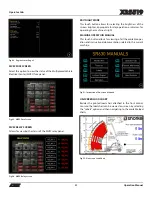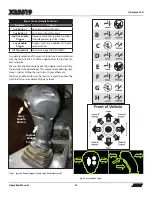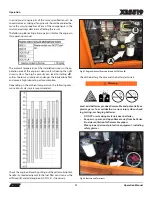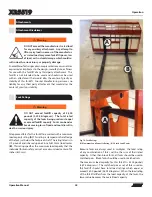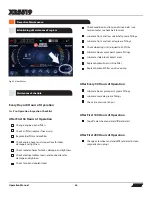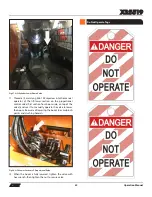
Operation Manual
54
XR5519
Operation
Steering Modes
Forklift Travel
Warning
Never use crab or four wheel (4W) steering
for traveling at high speeds. Use only two
wheel (2W) steering for higher speed travel
and slow the forklift before turning. Rapid
turning using crab or four wheel (4W) steer-
ing could cause tip over, which could result in death, serious
injury, or property damage.
Check the turning radius around the forklift before making
a turn, especially if using four wheel (4W) steering, which
provides a tighter turning radius. Look over your shoulder
in the direction of the turn when backing. Failure to remain
aware of your turning radius area could result in death,
serious injury, or equipment damage.
Caution
DO NOT change steering modes until the forklift comes to a
complete stop.
The reach forklift includes three STANDARD modes of
steering; Crab, Two Wheel (2W), and Four Wheel (4W) Steering.
Use the Steering Select switch located on the dash panel to
change steering modes.
Crab steering allows all four (4) wheels to turn
in the same direction as the steering wheel,
allowing the forklift to move “sideways”. Crab
steering is useful in a congested work site to
line up to a loading location.
Crab Steering
Two wheel (2W) steering allows the front
wheels to turn in the same direction as the
steering wheel. The rear wheels remain in
a fixed forward position. Two wheel (2W)
steering is useful for traveling at higher speeds.
Two Wheel Front Steering (2W)
Four wheel (4W) steering allows the front
wheels to turn in the same direction and the
rear wheels to turn in the opposite direction
of the steering wheel. The rear wheels follow
the front wheel path. Four wheel (4W) steering
Four Wheel Steering (4W)
is useful for a short turning radius and in muddy or sandy
conditions.
Fig 72. Maximum Fork Sweep
Warning
Allow for adequate clearance between the
attachment and other objects when turning.
The attachment extends beyond the front
of the forklift. The operator must be aware
of the maximum sweep of any attachment
being used, when turning, to avoid hitting personnel and
other objects in the area to prevent death, serious injury, or
property damage.


